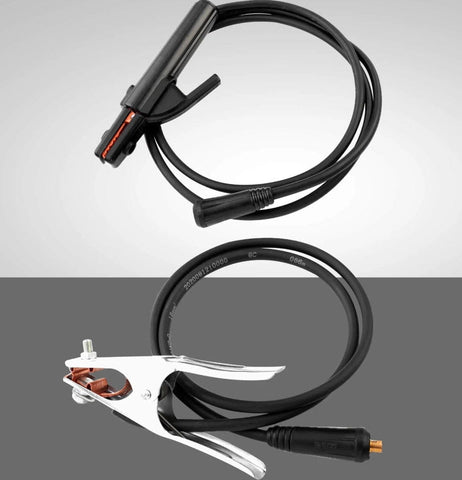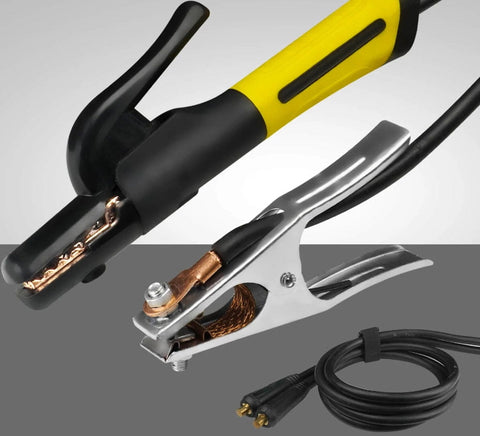Different Types of Welding Rods
Nov 13, 2023
| Electrode | Coating | Position | Current | Penetration | Tensile strenght |
| E6010 | High cellulose sodium | All Positions | DCEP | Deep | 60 000 PSI |
| E6011 | High cellulose potassium | All Positions |
DCEP AC |
Deep | 60 000 PSI |
| E6012 | High titania sodium | All Positions |
DCEP AC |
Medium | 60 000 PSI |
| E6013 | High titania potassium |
All positions |
DCEP DCEN AC |
Shallow | 60 000 PSI |
| E7018 | Iron power low hydrogen | All positions |
DCEP AC |
Shallow to medium | 70 000 PSI |
| E7024 | Iron power low hydrogen | Flat horizental |
DCEN AC |
Shallow to medium | 70 000 PSI |
How are welding rods named?
The initial pair of digits in the 4-digit number and the initial trio of digits in the 5-digit number serve as indicators for the tensile strength.
To illustrate, E6010 denotes a tensile strength of 60,000 pounds per square inch (PSI), while E10018 signifies a tensile strength of 100,000 psi.
The penultimate digit conveys information about the welding position:
"1" designates all-position electrodes, "2" pertains to flat and horizontal electrodes, and "4" corresponds to flat, horizontal, vertical down, and top electrodes. The concluding two digits delineate the coating type and welding current.
Introduction of Each Rods
E6010
| Deposited Chemical Composition % (Typical) | C = 0.08 | |
| Mn = 0.50 | ||
| Si = 0.20 | ||
| Deposited All Weld Metal Properties % (Typical) As Welded | Tensile Strength | 68,200 psi |
| Yield Strength | 60,000 psi | |
| Elongation in 2″ | 26% | |
| Recommended Welding Parameters | Diameter | Amperage |
| 3/32″ | 40-80 | |
| 1/8″ | 70-130 | |
| 5/32″ | 100-180 | |
E6010 is an all position, cellulosic electrode that has a quick-starting, steady and deep penetrating arc. It produces x-ray quality welds in all positions. E6010 was developed for the pipe welding industry.
Typical Applications: general purpose fabrication, maintenance welding, out of position x-ray welds, construction and shipbuilding, pipe welding, vertical and overhead plate welding.

E6011
| Deposited Chemical Composition % (Typical) | C = 0.08 | |
| Mn = 0.50 | ||
| Si = 0.20 | ||
| P = 0.012 | ||
| S = 0.021 | ||
| Deposited All Weld Metal Properties % (Typical) As Welded | Tensile Strength | 73,500 psi |
| Yield Strength | 60,000 psi | |
| Elongation in 2″ | 24% | |
| Reduction of Area | 67% | |
| Recommended Welding Parameters | Diameter | Amperage |
| 3/32″ | 70-80 | |
| 1/8″ | 110-130 | |
| 5/32″ | 130-160 | |
E6011 is a mild-steel, all position electrode designed primarily for use on AC power sources. It produces a strong arc force for deep penetration and a fine spray transfer that enhances operator appeal. Fast freezing or rapid solidification of the metal allows welding in the vertical and overhead position. Its light slag eliminates slag holes that are prevalent on some applications with other electrodes. This product can be suited in a wide range of applications.
Typical Applications: general purpose fabrication, galvanized steel work, structural work, shipbuilding.
E6013
| Deposited Chemical Composition % (Typical) | C = 0.08 | |
| Mn = 0.50 | ||
| Si = 0.40 | ||
| Deposited All Weld Metal Properties % (Typical) As Welded | Tensile Strength | 76,500 psi |
| Yield Strength | 66,500 psi | |
| Elongation in 2″ | 25% | |
| Recommended Welding Parameters | Diameter | Amperage |
| 3/32″ | 60-110 | |
| 1/8″ | 90-140 | |
| 5/32″ | 110-180 | |
E6013 is a mild-steel, all position, general purpose cellulose-base rod. It operates on AC or DC welding current and works well on low voltage AC machines. E6013 is an excellent choice where there is poor fit-up in the joint. It deposits easily and smoothly producing medium to shallow penetration. Small sizes are well adapted to low heat and thin metals. Medium to heavy slag is easily removed and provides for excellent weld cleaning action during the welding process. E6013 is a great selection for all types of mild steel fabrications or repairs where ease of operation and good bead appearance are required
Typical Applications: general purpose fabrication, metal buildings and structures, machine parts, shaft buildup
E7018
| Deposited Chemical Composition % (Typical) | C = 0.07 | Ni = 0.02* |
| Mn = 0.87* | Cr = 0.03* | |
| Si = 0.61 | Mo = 0.01* | |
| P = 0.015 | V = 0.01* | |
| S = 0.011 | ||
| Deposited All Weld Metal Properties % (Typical) As Welded | Tensile Strength | 82,670 psi |
| Yield Strength | 69,610 psi | |
| Elongation in 2″ | 30% | |
| Recommended Welding Parameters | Diameter | Amperage |
| 3/32″ | 80-110 | |
| 1/8″ | 100-1850 | |
| 5/32″ | 130-200 | |
E7018 is a low-hydrogen iron powder type electrode that produces high quality x-ray welds. It can be used in all positions on AC or DC reverse polarity welding current. E7018/E7018-1 is recommended for welding medium grade carbon steels where no preheat is used, and on cold rolled steels normally exhibiting excessive porosity when welded with conventional electrodes.
Typical Applications: low-alloy structurals, low, medium and high carbon steels, offshore rigs and power plants, steel structures, tack welds for tubular wire applications

E7024
| Deposited Chemical Composition % (Typical) | C = 0.08 | Ni = 0.02* |
| Mn = 0.78* | Cr = 0.03* | |
| Si = 0.35 | Mo = 0.01* | |
| P = 0.020 | V = 0.01* | |
| S = 0.014 | Sum = 0.85 | |
| Deposited All Weld Metal Properties % (Typical) As Welded | Tensile Strength | 82,670 psi |
| Yield Strength | 69,610 psi | |
| Elongation in 2″ | 28% | |
| Recommended Welding Parameters | Diameter | Amperage |
| 1/8″ | 110-150 | |
| 5/32″ | 140-190 | |
| 3/16″ | 200-250 |
E7024 is a high speed, iron powder, heavy coated electrode for high deposition rates on horizontal and down hand welding. Excellent bead appearance and self-cleaning slag give it operator appeal. This electrode has good weldability and superior mechanical properties and is particularly useful in obtaining increased penetration with little or no root porosity in horizontal or positioned fillets.
Typical Applications: shipbuilding, bridges, structural steels, machine bases, truck fabrication, storage tanks.
Although the welding industry is developing rapidly nowadays, Stick welding is still an indispensable function. In other words, some welders just like Stick welding. Take a look at SSimder’s Stick welding series welding machines. Enjoy 20% Off at Thanksgiving Sale!




1 comment
I would like too know ,What kools the welder down, If using large electrods .Such as 8018, or Jet Rods 7024. An how many Watts would it take too Weld with if not using Household 110,220,wattage .Thx